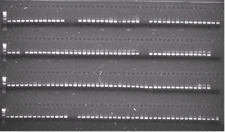Archival Notice
This is an archive page that is no longer being updated. It may contain outdated information and links may no longer function as originally intended.
Home | Glossary | Resources | Help | Contact Us | Course Map
Slab gels were the first media used for the separation of amplified product in forensic DNA analysis. The basic method entails the mixing of gel materials together with a buffer and pouring it into a mold to define the gel structure. The gels may be formed in a vertical or horizontal format. The slab-gel medium is supported on a backing of glass or plastic, or sandwiched between two glass plates, and then inserted into a chamber, which is most often made of Plexiglas®.
Gel combs are used in the molding process to form wells. The amplified DNA samples are placed in the gel wells and exposed to an electric field while submerged in a buffer solution. The amplicons migrate through the gel in lanes defined by the samples wells, in response to the field. Smaller molecules move faster and farther than the larger ones. The amplicons are visualized using a staining technique or with florescent tags, resulting in sample bands that have a bar-code pattern representing the different-sized molecules. Slab gels, once popular techniques, have largely been replaced by capillary electrophoresis methods, which are easier to use, increase resolution, and automatable. The theory of electrophoresis is the underlying basis for these methods.
Slab-gel Electrophoresis Steps |
|---|
|
The electrophoretic separation of molecules depends on two forces: charge and mass. The DNA molecules are negatively charged and have a constant charge-to-mass ratio since the negative charges along the phosphate backbone are evenly spaced. The charges on the DNA molecules are essentially equivalent; therefore, the separation is based on mass alone. The electrical current from one electrode, the cathode, repels the molecules, while the anode simultaneously attracts them. The gel matrix acts as a molecular sieve. During the electrophoresis, the molecules are forced to move through the gel matrix, separating the amplified DNA products by size. The separation medium contains a denaturant in order that the electrophoresis is conducted on single-stranded DNA fragments. Single-stranded DNA fragments are more similar to each other than double-stranded DNA fragments are to each other. Double-stranded DNA produces more electrophoretic diversity due to its three-dimensional structure.
Many factors can influence the migration and separation of amplified DNA products. These factors include both the physical and chemical environment. Alteration of the gel matrix, apparatus, and buffer can have dramatic effects on the electrophoretic system.
Ohm's law:
V=IR, where:
- V = voltage
- I = current
- R = resistance
Ohm's law demonstrates that an increase in voltage with a constant resistance will increase the current.
A discussion of electrophoresis would not be complete without introducing Ohm's law. When voltage is applied to the gel by the two electrodes, the current is influenced by the resistance of the gel. When resistance is constant, then voltage and current are proportional. Increasing the current will cause an increase in the voltage. Increasing the current will increase movement of the ions through the gel, thus decreasing the time for the fragments to pass the required distance. Voltage (V) is the product of current (I) and resistance (R); therefore, V/R determines current (I). Current produces heat, which must be dissipated or it will be absorbed by the system. Excessive heat can cause the DNA sample to migrate irregularly within the sample lane, resulting in the generation of sample bands that "smile." In very severe cases, the gel can literally fall apart.
Additional Online Courses
- What Every First Responding Officer Should Know About DNA Evidence
- Collecting DNA Evidence at Property Crime Scenes
- DNA – A Prosecutor’s Practice Notebook
- Crime Scene and DNA Basics
- Laboratory Safety Programs
- DNA Amplification
- Population Genetics and Statistics
- Non-STR DNA Markers: SNPs, Y-STRs, LCN and mtDNA
- Firearms Examiner Training
- Forensic DNA Education for Law Enforcement Decisionmakers
- What Every Investigator and Evidence Technician Should Know About DNA Evidence
- Principles of Forensic DNA for Officers of the Court
- Law 101: Legal Guide for the Forensic Expert
- Laboratory Orientation and Testing of Body Fluids and Tissues
- DNA Extraction and Quantitation
- STR Data Analysis and Interpretation
- Communication Skills, Report Writing, and Courtroom Testimony
- Español for Law Enforcement
- Amplified DNA Product Separation for Forensic Analysts



